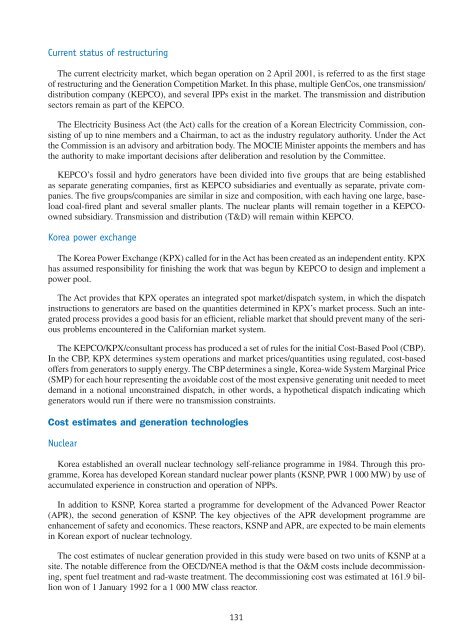Projected Costs of Generating Electricity - OECD Nuclear Energy ...
Projected Costs of Generating Electricity - OECD Nuclear Energy ...
Projected Costs of Generating Electricity - OECD Nuclear Energy ...
You also want an ePaper? Increase the reach of your titles
YUMPU automatically turns print PDFs into web optimized ePapers that Google loves.
Current status <strong>of</strong> restructuring<br />
The current electricity market, which began operation on 2 April 2001, is referred to as the first stage<br />
<strong>of</strong> restructuring and the Generation Competition Market. In this phase, multiple GenCos, one transmission/<br />
distribution company (KEPCO), and several IPPs exist in the market. The transmission and distribution<br />
sectors remain as part <strong>of</strong> the KEPCO.<br />
The <strong>Electricity</strong> Business Act (the Act) calls for the creation <strong>of</strong> a Korean <strong>Electricity</strong> Commission, consisting<br />
<strong>of</strong> up to nine members and a Chairman, to act as the industry regulatory authority. Under the Act<br />
the Commission is an advisory and arbitration body. The MOCIE Minister appoints the members and has<br />
the authority to make important decisions after deliberation and resolution by the Committee.<br />
KEPCO’s fossil and hydro generators have been divided into five groups that are being established<br />
as separate generating companies, first as KEPCO subsidiaries and eventually as separate, private companies.<br />
The five groups/companies are similar in size and composition, with each having one large, baseload<br />
coal-fired plant and several smaller plants. The nuclear plants will remain together in a KEPCOowned<br />
subsidiary. Transmission and distribution (T&D) will remain within KEPCO.<br />
Korea power exchange<br />
The Korea Power Exchange (KPX) called for in the Act has been created as an independent entity. KPX<br />
has assumed responsibility for finishing the work that was begun by KEPCO to design and implement a<br />
power pool.<br />
The Act provides that KPX operates an integrated spot market/dispatch system, in which the dispatch<br />
instructions to generators are based on the quantities determined in KPX’s market process. Such an integrated<br />
process provides a good basis for an efficient, reliable market that should prevent many <strong>of</strong> the serious<br />
problems encountered in the Californian market system.<br />
The KEPCO/KPX/consultant process has produced a set <strong>of</strong> rules for the initial Cost-Based Pool (CBP).<br />
In the CBP, KPX determines system operations and market prices/quantities using regulated, cost-based<br />
<strong>of</strong>fers from generators to supply energy. The CBP determines a single, Korea-wide System Marginal Price<br />
(SMP) for each hour representing the avoidable cost <strong>of</strong> the most expensive generating unit needed to meet<br />
demand in a notional unconstrained dispatch, in other words, a hypothetical dispatch indicating which<br />
generators would run if there were no transmission constraints.<br />
Cost estimates and generation technologies<br />
<strong>Nuclear</strong><br />
Korea established an overall nuclear technology self-reliance programme in 1984. Through this programme,<br />
Korea has developed Korean standard nuclear power plants (KSNP, PWR 1 000 MW) by use <strong>of</strong><br />
accumulated experience in construction and operation <strong>of</strong> NPPs.<br />
In addition to KSNP, Korea started a programme for development <strong>of</strong> the Advanced Power Reactor<br />
(APR), the second generation <strong>of</strong> KSNP. The key objectives <strong>of</strong> the APR development programme are<br />
enhancement <strong>of</strong> safety and economics. These reactors, KSNP and APR, are expected to be main elements<br />
in Korean export <strong>of</strong> nuclear technology.<br />
The cost estimates <strong>of</strong> nuclear generation provided in this study were based on two units <strong>of</strong> KSNP at a<br />
site. The notable difference from the <strong>OECD</strong>/NEA method is that the O&M costs include decommissioning,<br />
spent fuel treatment and rad-waste treatment. The decommissioning cost was estimated at 161.9 billion<br />
won <strong>of</strong> 1 January 1992 for a 1 000 MW class reactor.<br />
131

















